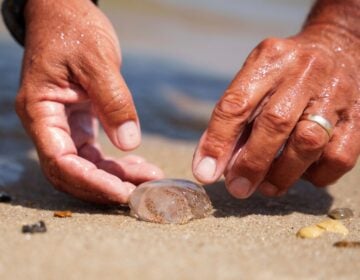Delaware’s piping plover chicks remain at risk from climate change, predators and humans
Though conservation efforts have helped to improve piping plover pairings, researchers say fledgling numbers are not keeping pace.
Listen 1:38
File: A piping plover runs across the beach in Phippsburg, Maine, in June 2006. The threatened shorebird is being seen in record numbers on Maine beaches during summer 2022. (AP Photo/Pat Wellenbach, File)
This story is part of the WHYY News Climate Desk, bringing you news and solutions for our changing region.
From the Poconos to the Jersey Shore to the mouth of the Delaware Bay, what do you want to know about climate change? What would you like us to cover? Get in touch.
Piping plovers, which hide along coastal areas aided by their camouflaged sandy-colored backs, are difficult to spot until their little orange legs scuttle across the beach.
“They’re just tiny little marshmallows on legs running around the beach, and it’s the cutest thing ever invented,” said Kat Christie, a coastal waterbird biologist for Delaware’s Division of Fish and Wildlife.
The presence of these small, round shorebirds, notable for their white chests and black collars, indicates a healthy beach ecosystem. But piping plovers, which nest in the sand, are threatened by human activity, storms and predators.
In Delaware, conservation efforts are proving successful as the number of breeding pairs held steady during an annual count of the birds this year. However, issues such as predation and extreme weather meant fewer of their chicks were able to grow into flying age this year.
The birds arrive and nest on Delaware’s beaches in March, and typically migrate south by September.
Piping plovers have been listed as threatened under the federal Endangered Species Act since 1986, and are considered endangered in Delaware, because of development and increased public use of the beaches these shorebirds nest on. They also face the threat of newly introduced predators such as red foxes, which are attracted to areas with more people.
“Plovers just don’t tend to do well on highly disturbed beaches, both because of the sensitivity of those nests where they can so easily be destroyed, and the birds, they’re territorial — where one plover pair sets up a nest, no other plover pairs are allowed to set up right next door or they’ll be fighting constantly,” Christie said.
Coastal states like Delaware have worked to conserve the birds — educating beachgoers, installing fencing and closing some parks during breeding season to protect their habitat. In the mid-1980s, there were fewer than 800 pairs along the Atlantic Coast. Today, there are about 2,000 pairs, distributed unevenly.
Delaware’s Department of Natural Resources and Environmental Control announced this week that this year’s piping plover pairings held steady — up to 30 breeding pairs from last year’s count of 24 — reflecting the available habitat in the state.
However, the birds’ attempts to raise healthy chicks were not quite as successful as biologists had hoped. The state calculated a .9 productivity rate, which is below the U.S. Fish and Wildlife Service’s goal of 1.5 fledglings per pair. Delaware’s piping plovers raised 27 fledgings (25 days old), compared to 41 a year ago.
The decrease was caused by predation, some large storms and a heatwave in late June that potentially contributed to chick and nest loss, Christie said. She added that the results could have been worse considering the poor conditions, and called the numbers “on par” with other years.
As climate change threatens extreme heat and more intense storms, however, biologists are concerned that piping plovers’ nests could be at an increased risk of harm.
“Sometimes they can benefit from a big storm that knocks out some vegetation. Sometimes that storm could come at the wrong time and knock out all their nests,” Christie said. “Some change tends to be good for this particular species — big change, not so much. More intense storms coming throughout the summer is overall not going to be good for a species that’s nesting right by the water.”
Nesting areas at The Point and Fowler Beach remain closed through Oct. 1 to protect foraging areas for migrating shorebirds, including fledglings leaving their territories for the first time.
“In Delaware in particular, where we have this resident breeding population, it’s protecting those closed areas, careful habitat management and respecting cohabitating with these birds, even if sometimes that means one area is theirs and another area is ours,” Christie said.
WHYY is your source for fact-based, in-depth journalism and information. As a nonprofit organization, we rely on financial support from readers like you. Please give today.






